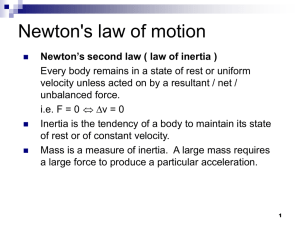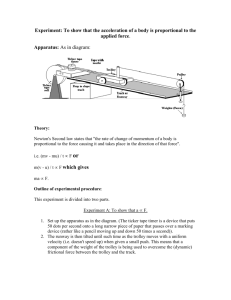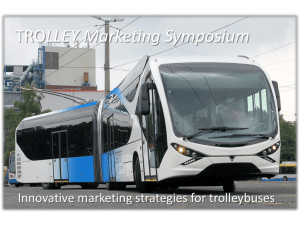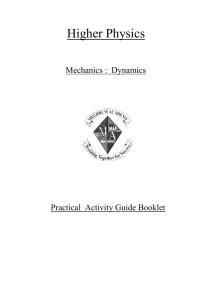report
advertisement
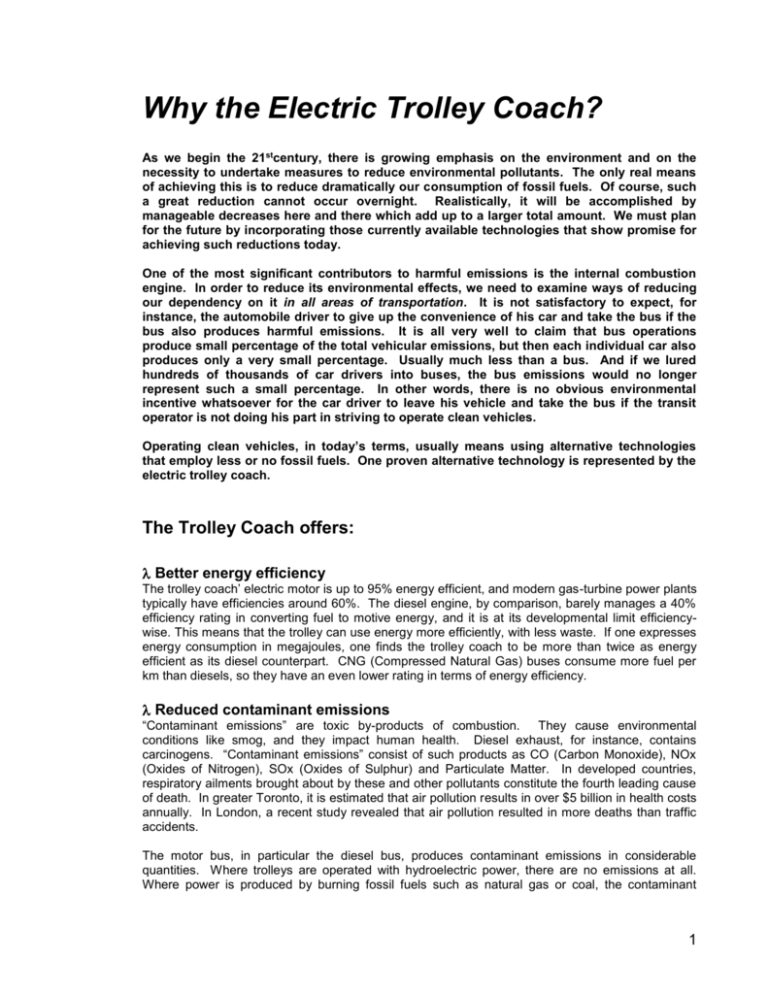
Why the Electric Trolley Coach? As we begin the 21stcentury, there is growing emphasis on the environment and on the necessity to undertake measures to reduce environmental pollutants. The only real means of achieving this is to reduce dramatically our consumption of fossil fuels. Of course, such a great reduction cannot occur overnight. Realistically, it will be accomplished by manageable decreases here and there which add up to a larger total amount. We must plan for the future by incorporating those currently available technologies that show promise for achieving such reductions today. One of the most significant contributors to harmful emissions is the internal combustion engine. In order to reduce its environmental effects, we need to examine ways of reducing our dependency on it in all areas of transportation. It is not satisfactory to expect, for instance, the automobile driver to give up the convenience of his car and take the bus if the bus also produces harmful emissions. It is all very well to claim that bus operations produce small percentage of the total vehicular emissions, but then each individual car also produces only a very small percentage. Usually much less than a bus. And if we lured hundreds of thousands of car drivers into buses, the bus emissions would no longer represent such a small percentage. In other words, there is no obvious environmental incentive whatsoever for the car driver to leave his vehicle and take the bus if the transit operator is not doing his part in striving to operate clean vehicles. Operating clean vehicles, in today’s terms, usually means using alternative technologies that employ less or no fossil fuels. One proven alternative technology is represented by the electric trolley coach. The Trolley Coach offers: Better energy efficiency The trolley coach’ electric motor is up to 95% energy efficient, and modern gas-turbine power plants typically have efficiencies around 60%. The diesel engine, by comparison, barely manages a 40% efficiency rating in converting fuel to motive energy, and it is at its developmental limit efficiencywise. This means that the trolley can use energy more efficiently, with less waste. If one expresses energy consumption in megajoules, one finds the trolley coach to be more than twice as energy efficient as its diesel counterpart. CNG (Compressed Natural Gas) buses consume more fuel per km than diesels, so they have an even lower rating in terms of energy efficiency. Reduced contaminant emissions “Contaminant emissions” are toxic by-products of combustion. They cause environmental conditions like smog, and they impact human health. Diesel exhaust, for instance, contains carcinogens. “Contaminant emissions” consist of such products as CO (Carbon Monoxide), NOx (Oxides of Nitrogen), SOx (Oxides of Sulphur) and Particulate Matter. In developed countries, respiratory ailments brought about by these and other pollutants constitute the fourth leading cause of death. In greater Toronto, it is estimated that air pollution results in over $5 billion in health costs annually. In London, a recent study revealed that air pollution resulted in more deaths than traffic accidents. The motor bus, in particular the diesel bus, produces contaminant emissions in considerable quantities. Where trolleys are operated with hydroelectric power, there are no emissions at all. Where power is produced by burning fossil fuels such as natural gas or coal, the contaminant 1 emissions produced per km of transit service is still far less with the trolley than the diesel or even the CNG bus. The Toronto Transit Commission recently noted that the emissions reductions achieved with CNG buses when they were new rapidly disappeared as the mileage accumulated. Diesel bus operations are responsible for anywhere between 18 and 45 tonnes of contaminant emissions for each million km of service. In Edmonton, Alberta, for example, where power comes from coal and natural gas, each million km of trolley service results in a reduction in toxic air contaminants of about 24 tonnes. On streets with frequent bus service, contaminant emissions present an immediate hazard to pedestrians and transit patrons. This is particularly so in areas with dense pedestrian traffic, such as found in a city’s downtown core. According to Prof. Dale Hattis of Clark University, regular exposure to as little as 1 microgram per cubic meter of diesel exhaust is estimated to result in 230350 additional cancer cases per million population. Street level air along heavily traveled diesel transit routes typically contains concentrations many times higher than this. The trolley coach produces no in-street emissions and therefore does not have the direct health impact on pedestrians and transit users that internal combustion vehicles have. Trolley coaches are highly effective in mitigating transportation impacts on the community and environment by reducing contaminant emissions from transit sources. Reduced noise Noise is also a pollutant. Exposure to noise above 85 decibels can cause hearing loss. Studies show that the passing of a trolley coach is not audible above the ambient street noise. The diesel bus, however, particularly when accelerating, produces up to 175 times more noise energy than the trolley and is a definite negative influence in efforts to establish quieter streets and neighborhoods. Diesel buses typically produce noise at levels between 80 and 90 decibels, depending on the vehicle, engine size and make. CNG vehicles are slightly quieter at 75 decibels, but are still no match for the silence of the trolley. Reduced vehicle maintenance Electric motors are relatively simple and require very little maintenance. Diesel engines, by contrast, have many moving parts and require constant maintenance to keep them in proper working order. The frequent oil changes and cooling system maintenance diesels need also contribute to depletion of non-renewable resources and environmental degradation. Although the diesel engine has reduced maintenance requirements compared to a gasoline engine, it still requires many times the number of maintenance staff hours and parts when compared with an electric motor, and these requirements increase considerably as it ages. In the late 1970’s in Edmonton, the amount spent on maintaining diesel buses built in the late 1950’s was 10 times greater than the expenditures required to keep trolleys on the road that were at least 10 years older than the diesels! CNG buses have made themselves unpopular in many cities because their maintenance demands were even higher than for diesel buses. Potential to reduce greenhouse emissions Carbon dioxide (CO2) is the most significant greenhouse gas behind global warming. Collected data indicates that up to 40% of the non-naturally occurring CO2 comes from transportation sources. Implicated is the internal combustion engine. In addition to reducing contaminant emissions, electric transportation such as the trolley coach can also play a role in CO2 reduction. Where trolley coaches operate solely on hydroelectricity, such as in Vancouver, British Columbia, the trolley coach is a true zero-emission vehicle (ZEV), and no CO2 is produced. In fact, Vancouver has proposed to sell the carbon credits earned with its trolley coach operation. In cities where trolleys use grid power generated from fossil fuels, greenhouse emissions are produced, but the amount of CO2 per vehicle km is often markedly less than with internal combustion powered buses. On heavily traveled routes in the UK, a per km reduction of 50-65% 2 over diesel levels could be realized with trolleys using grid power. Even where CO2 emissions from power plants are currently high, the ongoing efforts to reduce these emissions hold greater promise for greenhouse gas reduction in the long run than the internal combustion engine. It is much easier to control and reduce emissions from a single power source than from small, mobile sources such as vehicle engines. CNG buses actually increase greenhouse gas production. They emit almost as much C02 as diesels, but in addition they also produce fair quantities of methane. Methane has a greenhouse gas value 21 times greater than carbon dioxide. Best ride quality A comparison of vehicle ride qualities in a recent Vancouver bus technology report concluded that the trolley coach offers the best ride quality. Noise levels are lower, and the ride is smoother and free of the vibrations and jerky transmission shifts associated with internal combustion vehicles. Increased transit patronage A 1996 poll of passengers in Arnhem showed that the trolley coach had great appeal, sufficient to convince the authorities to invest in extensions and upgrading of the system that already carries nearly 80% of public transport users. A 1993 Edmonton study showed that four-fifths of respondents preferred to see investments made in electric transit modes rather than diesel buses, and the majority said that their minds would not be changed even if electric transit were more expensive. One can assume a correlation with ridership. In fact, data from other cities has borne this out. In San Francisco, California, ridership dropped by up to 15% on trolley routes when diesel buses were substituted. On the other hand, ridership increased by up to 18% when bus routes were converted from diesels to electric trolleys. Seattle, Washington has reported ridership increases of up to 10% when lines were electrified. Cleveland, Ohio expects to achieve at least a 10% ridership increase with the introduction of its 5-mile trolley coach line on Euclid Avenue in 2004. Better quality of life All of these qualities translate into a better quality of life, both for transit users as well as for residents of the community. Quality of life is an important consideration in making a city a habitable place for its residents as well as in attracting people to specific areas for work, leisure, shopping, etc. A transit system that adds to harmful emissions in densely populated pedestrian, residential and business areas and passes along the street with a tumultuous roar is not optimally attractive to riders. Contaminant emissions from vehicular sources are known to impact health. Environmental impact studies in California estimate a cost of $75,000 per tonne of toxic air contaminants to the health care system. In a city with, say, 30 million km of transit service annually, even ‘clean’ diesel service would ring up a health bill of $40.5 million! Employing trolley coaches as much as possible helps to reduce the health impacts associated with providing public transit service. Trolley Coach Fact and Fiction Answers to some FAQ’s about the trolley coach How do operational costs compare with other technologies? Among North American cities operating both trolleys and internal combustion vehicles, most currently report slightly higher costs for the trolley. The additional costs are incurred essentially as a result of the maintenance to the overhead wire network; in other words, the additional money is NOT being spent for the consumption of fossil fuels. Maximizing the use of trolleys helps keep the per unit costs associated with trolley operations down because the expense to maintain the overhead will be divided by more vehicles operating more revenue hours. In some countries, the 3 price of petroleum is substantially higher than electricity, so the trolley’s total costs can be a equivalent to or less than diesel despite the added costs of overhead maintenance. In many cases, the environmental benefits of the trolley coach would, so to speak, come free. Overall, any additional operating expenses incurred from the use of trolleys versus other modes tend to be insignificant with respect to the entire cost of operating a transit system. Transit’s biggest costs are those associated with the operator, administration, equipment maintenance and garaging. In Edmonton, the additional operating expense of using trolleys vs. diesels over the past 10 years amounts to only 0.1% of the total transit budget. Of cities that operate multiple modes, many report that the highest operating costs are incurred with CNG vehicles. This is largely a result of the fuelling infrastructure required and the increased maintenance needed on such vehicles. As existing oil reserves become depleted, the price of diesel fuel will rise. Increases in the cost of diesel fuel have the potential to make the electric trolley more economical everywhere in spite of the added cost of the overhead network. What is the cost of installing trolley coach overhead? The trolley coach’ forte is on heavily travelled “mainline” routes with stable ridership, fairly frequent service and frequent stops. It is under these conditions that the trolley’s efficiencies and benefits are maximized. In North America, trolley coach infrastructure costs around $1 million per km of two way overhead. Compare this to light rail, which runs at around $17 to 35 million per km, and one realizes that trolley coach installations are relatively inexpensive for the benefits they offer. The high patronage on mainline routes quickly pays for the cost of the infrastructure. In cities that already have a trolley coach system, the cost of adding new lines or building extensions is small when compared to the capital value of the entire system. In fact, maximizing the utility value of the system by the addition of overhead, where necessary, adds to its worth as an asset and increases the environmental benefits possible with this technology. A straight line of overhead costs approximately £90,000 per kilometre with bracket arms and £120,000 with span wires. Curves cost £193/metre. Section insulators cost £2260 without cabling, frogs are £2770 and Crossings are £2260. Lighter, simpler fittings, that are less intrusive may reduce these figures. Are trolley coaches faster or slower than diesel buses? Typically, the trolley coach has much faster acceleration than the diesel bus, although newer diesel buses do much better in this area than older diesel models. Trolleys may have to slow down to enter switches and crossovers at intersections, but buses ought not to be speeding through intersections anyway. In comparison to conventional diesels, trolley coaches can work faster schedules with the consequence that less vehicles ought to be required to perform the same work. Speed of operation statistics for trolley coaches typically show them operating at slower average speeds than diesels, but this is because trolleys are used on heavily travelled routes with frequent stops, whereas diesels tend to operate into suburban areas with lower traffic density and fewer stops. A diesel working a downtown route on a tight schedule would be at a disadvantage compared to a trolley. Vancouver operators report difficulty in maintaining schedules when diesel buses are dispatched on trolley runs. Is the trolley coach flexible? 4 When passage along a street is totally blocked due to an accident or some other emergency and traffic is brought to a standstill, diesel and other internal combustion powered transit vehicles fare no better at getting around the situation than the trolley coach. Movement away from the overhead power supply can be made possible with Auxilliary Propulsion Units. One such unit would consist of a set of batteries that are kept charged by the overhead line current. In the event of the inability to draw power from the overhead, the trolley can travel several km on battery power. This is enough to move the vehicle around any obstruction, through de-energized sections, etc. In modern European practice a small [50Kw] diesel alternator set is often used to provide auxiliary power. Many cities maintain trolley coach operations at times of road construction, and here the trolley coach can also demonstrate considerable flexibility. Roadway improvement work on main thoroughfares typically proceeds only on one side of the street at a time. Traffic is still allowed passage by using the lanes on the side opposite to the construction. Overhead can easily be slid over on the span wires to allow trolleys to continue operating on the usable side of the street. Where overhead must be removed to allow construction work to proceed and detours along adjacent wired streets cannot be arranged, APU’s will power the trolleys through a de-energized or unwired section. The retention of motor buses for back-up purposes should be unnecessary and represents an unnecessary expense both in terms of maintenance and hostelling space. This money might be better spent on keeping trolleys on the road, thereby maximizing the return on taxpayer investments in trolley equipment, maximizing the environmental advantages, reducing per unit operating costs and maintaining good relations with the community. In heavily travelled corridors, the investment in trolley infrastructure provides route security. The socalled “flexibility in routing” associated with diesel buses has its price. Frequent route changes tend to discourage riders. Such changes—easily possible with diesel service—consume valuable service hours and often extend travel times. As a result, once direct services become convoluted, time-consuming and inefficient, prompting further ridership losses. How does the trolley fare in cold climates? The City of Moscow, Russia operates over 1600 trolley coaches on some 90 routes. They have one of the severest winter climates among trolley coach cities. The trolley coaches in Moscow are a highly reliable and revered form of public transportation. They have been nicknamed “soldiers of the streets”. In relation to poor weather conditions, the carbon inserts in the trolley shoe need to be changed more frequently. Sleet shoes are installed in winter to remove ice from the lines. However, consider that the trolley coach needs no refuelling. Staff time and costs are incurred in refuelling diesel buses on a daily basis, and refuelling the diesel exposes workers to toxic substances. Is the trolley coach ‘old’ technology? Internal combustion powered buses have been in common use in North America since the early 1900’s and somewhat longer in Europe. The trolley coach, by contrast, did not come into widespread use in Britain until the 1930’s. A combination of bus and electric streetcar, it is most certainly the newer, and as some have stated, “more civilized” form of urban bus transport. Just as diesel buses have evolved over time, so, too, has the trolley coach been improved upon. New trolley coaches use sophisticated electronic equipment and brushless AC motors, saving on power consumption and reducing maintenance. New trolley coaches can move considerable distances without need for overhead wires. Equipment is available to lower and raise the poles from the driver’s compartment. Even the design of trolley coach overhead has evolved considerably since the early days. The modern trolley coach is a very sophisticated piece of machinery. 5 The streetcar predates both the diesel and the trolley coach. Essentially, it is streetcar technology that underlies today’s light rail systems, yet few would consider LRT to represent ‘old’ technology. Is there a trend toward abandoning trolley coaches? No. In fact, over the past two decades, more than twice as many new trolley coach systems have been opened than were abandoned (Trolley coach Magazine (Issue No. 230) reports: Since 1980, 101 systems were opened worldwide, but only 47 were closed down). In the late 1950’s and throughout the 1960’s, many cities around the world traded their trolleys for diesel buses, including London which at one time had 1,700 vehicles operating over 250 miles of routes. At that time, there were few ecological alarms to signal that this would turn out to be a mistake environmentally. Furthermore, North American systems were suffering at the time from large ridership losses due to suburbanization and sought ways of reducing expenses and extending service to outlying areas at minimal capital cost. They readily accepted the promise that the diesel bus would offer some cost savings. In the U.S., there was also a move underway by producers of fossil fuels and manufacturers of diesel buses to supplant electric transport with internal combustion vehicles, ultimately putting trolley coach producers out of business. The environmental concerns and oil crises of the 1970’s drew attention to the value of electric bus transport, but, unfortunately, it was too late for those systems that had already been dismantled or were on the verge of closure. In the past two decades, with rising concerns about pollution have generated considerable interest in the trolley coach. A number of cities operating trolleys are expanding their systems. Examples include Linz and Salzburg, Austria; Guangzhou and Wu’han, China; Bergen, Norway; Dayton, Ohio. There have been recent proposals in Great Britain and Hong Kong to build new trolley coach systems. In North America, Mexico City and San Francisco are currently renewing their trolley fleets. Cleveland, Ohio is building a new, five-mile trolley coach system to relieve the problems of noise and emissions from diesel buses. City planners there firmly believe the trolley coach will be a key component in the revitalization of the Euclid corridor. Boston and Vancouver are planning to renew their trolley coach fleets in the next few years. Seattle has an overhead extension on the books and plans to install the reliable electric and electronic components from its current fleet of trolleys in new bodies as an economical fleet renewal option. Is the fuel cell bus a viable alternative to trolleys? The practical application of hydrogen fuel cells for motive power is a relatively new concept, and their feasibility and reliability in bus propulsion systems is yet unproven. Current test vehicles must carry so much heavy equipment that their passenger carrying capacity is about half of a 40 foot diesel or trolley coach. Vancouver tests showed that they were unsuitable for more than a few hours of service, and operational costs were very high. While this technology definitely holds promise and may become viable for some transportation applications in the future, it would appear at this time to be a poor rival for any existing technology, let alone the trolley coach. In order to utilize fuel cells to produce electricity, one requires large amounts of hydrogen. The most readily available methods of producing hydrogen currently involve fossil fuels. During the production process, the greenhouse gas CO2 is produced in quantities that are not vastly different from what an internal combustion engine would generate. Trolley coaches powered by clean, renewable power sources result in no greenhouse gas production at all, and modern gas-fired power plant turbines produce relatively small amounts. The fuel cell bus compares poorly with the trolley in terms of energy efficiency. It takes 4 kWh of electricity to produce, compress and transport 1 kWh worth of hydrogen. Looking at the tractive effort produced by fuel cell generated electricity, it takes a full 9 kWh of electricity to produce 1 kWh output at the wheels of the bus. A trolley coach without regenerative braking needs only 1.56 kWh of electricity to produce 1 kWh of tractive output, making it six times more energy efficient than a fuel cell bus. With regenerative braking on the trolley, the electricity required drops to around 1.1 6 kWh per kWh of tractive effort. It is unlikely that developments in fuel cell technology will reduce the difference in efficiency between fuel cell and trolley coach below a factor of five. The fuel cell developers’ goal is eventually to achieve 50% energy efficiency. This would be superior to the level attainable by diesel vehicles, which is around 40%. Thus the fuel cell bus may one day provide a logical and more environmentally friendly alternative to diesel buses. Trolley coaches as an alternative to new light rail? In Britain new light rail tramway systems cost from £4 million per kilometre if a existing heavy railway line can be taken over to as much as £20 million per kilometre for completely new construction featuring a high proportion of street related track [Manchester extension in 2000]. At £4 million/km, annual riderships of 0.5 million people per kilometre to justify such investment are readily achieved with trams running on former railway private right of way. At £20 million/km, riderships which need to be in the region of 2.5 million/km for similar cost effectiveness, may be difficult to achieve with trams running on street related track where average speeds and reliability are more comparable with a bus than a railway. Experience with light rail in Sheffield suggests that a maximum of only around 0.4 million/km is achievable on street related track in British conditions. In such situations, investment in high quality trolley coach routes featuring attributes normally associated with light rail such as high priority over other traffic, level boarding from raised platforms and no driver involvement in ticketing may be considerably more cost effective than light rail, yet provide the travelling public with a similar ambience to light rail and attract similar riderships. A high quality trolley coach route – a “trolleyway” – should cost no more than £1 million/km and would need a ridership of only about one twentieth of that required for light rail to justify it. Can the latest “clean diesel” technology using Ultra Low Sulphur Diesel fuel (ULSD) and Continuously Regenerating particulate Traps (CRT) compete with electric buses in terms of emissions impacts? No. Vehicle emissions have their greatest impacts on those directly exposed, i.e. pedestrians, transit users, those living in busy transportation corridors. Trolley coaches produce no in-street emissions. Unless all the emissions diesels release into the surrounding air can be completely eliminated, the diesel can never be competitive with an electric trolley coach in terms of emissions impacts. This should not imply that efforts to reduce diesel emissions are wasted. Since diesel engines will continue to be used for a variety of purposes, every effort should be made to make them as clean as possible. But one needs to realize that making an internal combustion engine cleaner does not make it a universal substitute for an electric vehicle. There are a number of factors to consider: Greenhouse Gases: Currently available data from the British Freight Transport Association (FTA, 1999) indicates that the production of ULSD [at refineries] results in some 20 tonnes more CO2 equivalent than the production of regular diesel. Indications are that powering a vehicle with ULSD requires more fuel than with regular diesel, meaning that, while some emissions may be reduced, the amount of CO2 released by the vehicle is likely to be greater. Based on available data, one would conclude that the use of ULSD does nothing to reduce the greenhouse gases responsible for global warming. Particulate Size: Trap devices such as the CRT primarily focus on reducing the amount of particulate matter that diesels spew into the surrounding air; there is also some concurrent reduction in hydrocarbon emissions. Some traps claim to reduce particulate emissions by up to 90% in tests, although their performance in real-world conditions may vary considerably. In any case, some particulate is still released, and that particulate is very minute in size. It is so small that 7 it is invisible to the naked eye, but it quickly and easily penetrates the linings of the lungs. The Daily Mail of December 27, 2000 reported that such particulate was found deeply imbedded in the lungs of very young children, in particular children who lived in homes located along busy corridors. This particulate is believed responsible for an increase in lung disorders and asthma and has also been linked to heart disease. The incidence of asthma in children under five has doubled in Britain in the last ten years and is on the rise in many other countries. NOx Emissions: In spite of trap devices, Oxides of Nitrogen (NOx) still form a major component of diesel exhaust and pose significant health risks in spite of the advent of ‘clean’ diesel technology and trap devices. Oxides of Nitrogen essentially comprise a mixture of Nitric Oxide (NO) and Nitrogen Dioxide (NO2). NOx is transportation’s principal contributor to urban smog and poor air quality. In combination with the moisture in the lungs, Nitric Oxide (NO) forms nitric acid. This acid results in inflammation, leading to chronic respiratory problems. Eventually, all Nitric Oxide emissions are converted to Nitrogen Dioxide (NO2) in the atmosphere. Nitrogen Dioxide is a corrosive and very poisonous gas. At concentrations above 150 ppm it leads to death. The CRT (Continuously Regenerating Trap) uses a catalyst to convert Nitric Oxide in the exhaust stream to NO2 because it needs the NO2 for a reaction that ‘burns off’ particulate matter and hydrocarbons. There is a strong likelihood that the proportion of NO2 in the NOx emitted by CRT equipped engines operating in real world conditions will be greater than is the case with non-CRT equipped diesels. If so, it would put a greater quantity of the more poisonous constituent of NOx emissions directly into the airways of pedestrians, transit users and area residents than would be the case with conventional diesels, where the a slower process of oxidation in the atmosphere would be required to yield the same quantity of NO2. In other words, there is every possibility that ULSD in combination with the CRT may actually intensify some of the health effects of diesel exhaust. Negative Environmental Repercussions: The environmental benefits of exhaust after-treatment devices was recently called into question when researchers discovered heavy metals from catalytic converters embedded in the ice in remote regions of Greenland. A European Commission study found that vehicle exhausts actually erode the metals in these devices, ejecting microscopic particles into the air. Some of these metals have also been linked to asthma and lung conditions. Researchers noted that some of these particles are soluble, meaning that they can be readily absorbed by vegetation and enter the food chain. New Scientist magazine concluded that this is already a problem is of global proportions. Kevin Brown The Electric Tbus Group. 26/11/00; amended 24/02/01 http://www.tbus.org.uk 8


